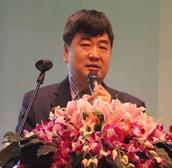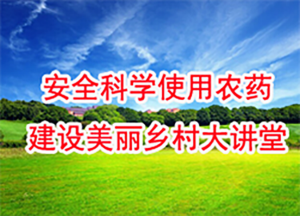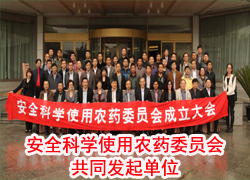
Interview: Chinese industry confident about 2017
責(zé)任編輯:By journalist Dr. Han Shuyou 來源:China Crop Protection Industry Association 日期:2017-03-27

Dr. Sun Shubao, head of CCPIA
Despite exports falling in value and volumes in 2016, Dr Shubao Sun, head of China Crop Protection Industry Association (CCPIA), feels that the most difficult time is over and exudes confidence about 2017. Dr Sun spoke to Agrow’s China correspondent, Dr Shuyou Han.
Journalist: Could you comment on current status of Chinese pesticide industry?
Shubao Sun: China leads the world in generic pesticide production. According to our statistics, there are more than 2,600 pesticide manufactures in China. Some 600 of those have the capacity to synthesis technical material. Over half the production is exported, with the rest being used in the domestic market. With exports playing a dominant role, the Chinese industry is driven largely by the requirements of foreign markets.
Chinese pesticide production has been declining since the second half of 2014. I think, the most important reasons for that have been lower grain as well as fossil oil prices. Farmers are smart business people and stop investing more once grain price drops. Lower fossil oil price is a double edged sword – it can promote pesticide production but can also drag down the whole value of the fine chemical industry. Furthermore, lower fossil oil price inhibits the development of the bio-ethanol industry, which needs maize and sugar cane as raw materials, resulting in more maize getting overstocked in the warehouse. With cheaper GM maize imported into China, the government is urging farmers to optimize the planting structure in the next few years. The government says that maize planting area will be decreased by 50 million mu (3.3 million ha) and soybean planting is going to be encouraged, which would reshape pesticide usage in China.
The government has changed its strategies on regulating planting structures. A few years ago, the basic goal was to feed ourselves by planting crops on 1,800 million mu crops (120 million ha). Now, we have transformed the old strategy into the current objective, which guarantees the rice and wheat planting area while other crop planting is adjusted by markets. China imports more than 80 million tonnes of soybeans from the US and Latin America each year to satisfy the needs of edible oil and feed. Just imagine the size of land needed to plant soybeans that would fulfill the needs without import.
About the pesticide production trend, I think the Chinese pesticide industry somehow contributes to lowering the global grain prices because farmers across the whole world are using our quality products at a reasonable price, at least compared with those of multinational companies (MNCs). That reduces farmers’ production cost, makes grain cheaper, and eventually results in weaker demand for pesticides -- it is a negative cycle. But things are full of ups and downs, which are regulated by markets, namely supply and demand. I hope the pesticide industry will overcome this difficult time sooner than expected.
It is not a secret that MNCs purchase technical and even formulations from about three dozen Chinese manufacturers. MNCs need to check the supplier’s Environmental Health and Safety (EHS) compliance regularly to ensure production continuously. Any potential accidents, such as leaking, explosions, could break the supply chain and do harm to procurement. Generally speaking, we benefit from strict EHS standards.
In order to maintain environmental standards, local governments occasionally force polluting manufacturers, no matter large or small ones, to shut down. As a result, the larger companies were hit by an environmental crackdown. As an example, lots of upstream raw materials/intermediates, such as glycine, are produced by small or medium companies in Shijiazhuang in Hebei province. Once a shutdown order is effected, the downstream pesticide production would be seriously affected since raw material suppliers (usually small companies) are shut down. Companies such as Wynca and Jiangshan used to have capabilities to synthesise their own glycine, but they eventually gave it up because sourcing from smaller companies turned out to be more profitable. So the occasional environmental crackdown actually leads to some negative effects on the whole industry.
Journalist: The government has a target to reduce the number of crop protection companies in China by 30% in the current five-year plan but progress towards this objective has been very slow. Do you think it will achieve this?
Shubao Sun: The reduction of crop protection companies by 30% was proposed by the CCPIA and supported by the government. Such a large number of small scale manufactures is not healthy to the country’s pesticide industry because it is hard to regulate the quality. The 30% reduction is an objective of the 13th five-year plan (2016-2020). We are moving in the right direction and have already got some things done. For instance, the Ministry of Industry and Information Technology (MIIT) has not approved any new pesticide manufacturing factory in the last two years. Mergers and acquisitions are encouraged if companies want to enrich their product portfolios or to produce something new.
Journalist: What is the status of the environmental crack down? Does that help to eliminate the small manufacturers? What are the impacts on big players? Is it a driver to move consolidation forward?
SS: The environmental protection policy acts as an encouragement to the mergers and acquisitions of pesticide manufacturers. In the matter of an action plan to protect our water and air, CCPIA and the Ministry of Environment checked the major glyphosate manufacturers in 2013, which resulted in the glyphosate herbicide price jumping up since a number of factories were closed down. I hope environmental checks happen regularly rather than occasionally. My logic is that the small manufacturers, with a lack of environmental protection facilities and strategies, cannot survive under higher pressure of environmental crackdown actions, while the larger ones, which are comply with environmental policy, can grow healthily.
Journalist: How has the year 2016 been for pesticide exports from China? What has been the situation for glyphosate exports and the price of the herbicide? What are the other important active ingredients for export?
SS: According to statistics, export volumes as well as product prices fell in 2016. The lower price of fossil oil and other raw material should be blamed for that. If you check the quarterly financial reports of the listed crop protection companies, you will find that their margins were very thin or even negative.
Let’s take glyphosate as an example, it accounts for 15% of exports. Actually, glyphosate is an indicator for the entire pesticide market. During the fourth quarter of 2016, glyphosate prices rose mainly because of two reasons: fossil oil prices doubled to $50 from $25 per barrel; and the environmental crackdown reduced production capacities partially. The CCPIA warns its members to keep the pesticide prices stable. We want crop protection companies to grow their business steadily and healthily rather than fluctuating like a roller coaster. Risk capital might be attracted to our industry if pesticide prices up rapidly.
Journalist: With rising labour and raw material costs, do you think Chinese companies will begin to turn to India for sourcing product?
SS: Actually, we import certain pesticides such as the insecticide, deltamethrin, the fungicide, mancozeb, and a few others from India now because their prices are more competitive. We also buy raw materials, such as pyridine and permethric acid from India. But India buys more from China than it sells to China so far. It is hard to predict whether China will buy more or not from India– the possibility is always there, but in my judgement, the chances are low. Pesticide production involves integrated technologies, including manufacturing process and environmental protection, and advanced facilities. The core technologies are not easy to be copied although making generic products is not comparable to new ai discoveries. Another key point is that the Chinese industry is vertically integrated and China synthesises pesticides right from scratch, namely raw materials. Plentiful sources of raw materials make China’s pesticide manufacturing industry prosperous and competitive. I do not think other countries can do it except India does it partially. Unlike toys, electronic products and clothing industries, which are sensitive to cost and price, pesticide industry is relatively more stable. I think Chinese pesticide industry still has room to improve.
Journalist: What has been the development in the domestic pesticide market in China in 2016 compared with 2015? What were the important factors that impacted the domestic market’s development in 2016?
SS: I think that the National Agricultural Technology Extension Service Centre (NATESC), and the Ministry of Agriculture (MoA), is more authoritative to answer this question than me. Based on the newly released partial data in Nanjing, 2016 has not been a good year in terms of pesticide market within China as both quantities and price of pesticides went down. I think the major reasons are the treated areas decreased due to the average level of pest infection pressure. Furthermore, low commodity prices are not favourable to the pesticide market.
Journalist: Are there any action plans on tax reimbursement for export, pesticide safety issues, and “zero-growth” on pesticide use in China?
SS: Currently, tax rebate for formulations is 5%, and that for technical pesticide ranges from 7% to 11%. I do not think it is an ideal situation. I suggest the tax rebate rate for formulations should be higher than that of technical grade. Not all of our policy makers are familiar with pesticide business. We need a bit of fine tuning to facilitate our exports.
The CCPIA, MNCs, and Chinese crop protection manufacturers have been working together to promote pesticide use safety. We found that the most important safety issues are not from manufacturing process and transportation; they are actually from pesticides abuses, such as over dosage, wrong application windows and so on.
Pesticides are one of the most important production materials that help farmers produce higher yield with good quality. No one blamed pesticides when we did not have enough to eat. Food safety issue became a big topic in China once we were able to feed ourselves. Pesticide residues got blamed for reduced food quality. How can we resolve those issues? I think we have two solutions. One is to pursue new technologies to increase pesticide efficacy, lower application dosage, and lower residue, which relies on new ai discovery and formulation innovations. The second is even more important, which is to educate farmers to use pesticide properly. To achieve this goal, the CCPIA, collaborating with the MoA and CropLife China initiated an education programme called “village lectures for farmers”. The CCPIA also provides crop protection solution training to farmers crop by crop.
Talking about the zero growth of pesticide use, we encourage smaller formulation manufacturers to be the crop protection service providers, supporting farmers to use pesticides scientifically. Recently, unmanned aerial vehicles have been employed to spray pesticides in fields; the advanced crop protection spray equipment plays an important role in reducing pesticide use while not compromising effectiveness. Another strategy is to teach farmers to use the economic threshold concept in practice. Farmers usually could not tolerate seeing moving worms in the field after spraying insecticides. We convince farmers that 85% efficacy is good enough to ensure high yield.
JOURNALIST: How do mergers and consolidations affect the Chinese pesticide industry?
SS: MNCs pay more attention to marketing surveys than do Chinese crop protection companies, so they can foresee what is going on in the future market and are well prepared for potential mergers and acquisitions. Fewer companies will be left after MNC mergers (Dow and Dupont) and acquisition (Bayer and Monsanto, ChemChina and Syngenta), fewer product lines will be available because of the dropping of duplicated products. On the negative side, monopoly power could choke innovation and also result in lowering the bargaining power of domestic technical suppliers. On the good side, Chinese companies can take advantage of the released production lines from the MNCs. For instance, Beijing Nutrichem bought whole product lines from Dow, which helped it penetrate the global market. In addition, Chinese crop protection companies could easily hire the experienced market/sales personnel because merger and acquisitions usually mean layoff sometimes.
Journalist: What is your outlook for the industry over the next five years?
SS: We know that the pesticide market is closely related to commodity price and fossil oil price. Pesticide price will be going up again since fossil oil prices will. There is always a periodic cycle such as the previous cycle from 2008 to 2013. I bet the pesticide price will vary within a reasonable range in the next cycle, big fluctuations are not likely going to happen (which happened during 2008 to 2013). Making a fortune overnight is not sustainable. In conclusion, the most difficult time has passed -- I am full of confidence for 2017.
Journalist: When do you think GM maize and GM soybeans will be allowed to be grown in China?
SS: In the past decade, China invested about Yuan 2,000 million ($290 million at the current rate) on GM crop research. The most successful story was Chinese Bt cotton, which has been widely grown and insecticide usage reduced. China has various GM crops stocked in laboratories in research institutes/universities, which are not commercially released yet. We do not know how good those GM crops are compared to those of MNCs.
In China, scientific communities and government seem to be in favour of GM crops. Why does ChemChina want to buy Syngenta? I think the main reason is for GM crops and other new innovations, not only for pesticides.
I think that it is possible to grow GM maize in China. We, however, have many limitations to compete with the Americas, such as our farmland size, seed selling channels and loyalty fees. I cannot see any possibilities to cultivate GM soybeans in the north or north-west of China despite the central government urging the expansion of soybean planting area. The reason is all about dietary habits, Chinese people love tofu, and many people cannot accept tofu made from GM soybeans.
Journalist: How would GM crops affect the Chinese pesticide industry in case the central government gives it a green light in the near future?
SS: The uses of the selective herbicides would be significantly reduced if Roundup Ready crops were allowed to be grown in China. At the same time, “super-weeds” will be an emerging problem, which leave rooms for selective herbicide business.
JOURNALIST: Can you comment on research in China and the discovery of new ais?
SS: Four Chinese crop protection companies entered Agrow’s top 20 club; they are big ones in terms of sales revenue and net profit. They are at least bigger than Japanese crop protection companies that have capabilities to synthesis new molecules. I think new ai discovery should be a direction or responsibility for Chinese companies. We have patented over 30 ais in the last decade, which were funded by research institutes rather than being driven by companies. The new ais do not seem to have achieved profitability due to a lack of sales strategies. The reason we are unable to catch up with Japanese research teams is that their ai discoveries are funded and driven by commercial crop protection companies -- their research is composed of molecule design, synthesis, screening, bioassay, toxicity studies and chemical fate, and we are mainly focusing on molecule synthesis.
Furthermore, our new ais have been mainly discovered in research institutes/universities, which are led by primary investigators, and performed by graduate students, including Masters, PhDs. I cannot deny that partial
findings/patents are driven by publishing scientific articles to achieve their professional titles. The fate of the discovered new ais are either being sold to MNCs or being commercially developed by Chinese companies. And those Chinese companies usually are too small to develop the new ais, which poses a problem – new ai discovery is not closely connected to product development. To me, ai discovery is system science. In the future, our ai discoveries should be driven by farmer’s needs, funded by commercial crop protection companies.
中國農(nóng)藥工業(yè)網(wǎng) 版權(quán)所有
地址:北京市朝陽區(qū)農(nóng)展館南里通廣大廈7層
電話:010-84885233 京公網(wǎng)安備11010502025163










